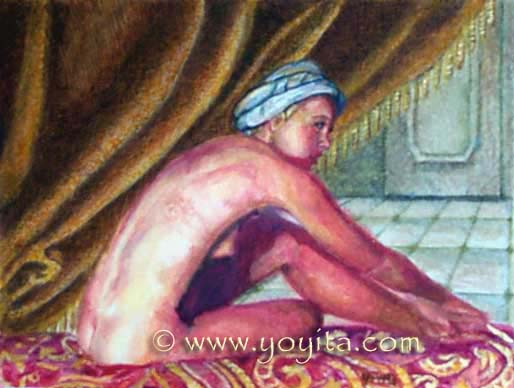Academic art, (nudes)It is a style of painting and sculpture produced under the influence of European academies or universities.
Specifically, academic art is the art and artists influenced by the standards of the French Académie des beaux-arts, which practiced under the movements of Neoclassicism and Romanticism, and the art that followed these two movements in the attempt to synthesize both of their styles, and which is best reflected by the paintings of William-Adolphe Bouguereau, Thomas Couture, and Hans Makart. In this context it is often called "academism", "academicism", "art pompier", and "eclecticism", and sometimes linked with "historicism" and syncretism.
The art influenced by academies and universities in general is also called "academic art". In this context as new styles are embraced by academics, the new styles come to be considered academic, thus what was at one time a rebellion against academic art becomes academic art.
The first academy of art was founded in Florence in Italy in 1562 by Giorgio Vasari who called it the Accademia dell' Arte del Disegno. There students learned the "arti del disegno" (a term coined by Vasari) and included lectures on anatomy and geometry. Another academy, the Accademia di San Luca (named after the patron saint of painters, St. Luke), was founded about a decade later in Rome. Academia di San Luca served an educational function and was more concerned with art theory. than Florentine Accademia dell' Arte del Disegno. Academia di San Luca later served as the model for the Académie royale de peinture et de sculpture founded in France in 1648, and which later became the Académie des beaux-arts. The French Académie very probably adopted the term "arti del disegno" which it translated into "beaux arts", from which is derived the English term "fine arts". The Académie royale de peinture et de sculpture was founded in an effort to distinguish artists "who were gentlemen practicing a liberal art" from craftsmen, who were engaged in manual labor. This emphasis on the intellectual component of artmaking had a considerable impact on the subjects and styles of academic art. After the royal Academy of painting and sculpture was reorganized in 1661 per Louis XIV of which the goal was to order all the artistic activity in France, a polemic occurred among the members who dominated of the artistic attitudes for the remainder of the century. This "battle of the models" was a surplus of conflict if Peter Paul Rubens or Nicolas Poussin were a suitable model to follow. Pousssin followers, called "poussinists", alleged that the line (disegn) should dominate art, because of its call to intellect, whereas the followers or Rubens, called the "rubenists", discussed this color (colours) should dominate art, because of its call to the emotion. The discussion was restored in the 19th century early, under the movements of Neoclassicism characterized by the drawing-model as a Jean Auguste Domenica Ingres, and Romanticism characterized by the drawing-model of Eugene Delacroix. There were discussions about if it were to better learn art by looking at nature, or to learn by looking at the artistic Masters from the past.
The academies employing the French model formed all over Europe, and imitated the lesson and the models of the French Academy. In England, it was the b>Royal Academy.
|
The Vault National Archives of Canada has this indications:
Caring for miniature portraits
Miniatures are extremely sensitive to light and should be stored in the dark and exhibited or shown always under low light levels at maximum 45 Lux except for pertinent photography and/or laboratory examination.
Miniatures should be kept in a cool, dry, dark place with a stable environment, ideally at 50% relative humidity (RH) and 18 degrees Celsius.
White cotton gloves must be worn at all times to handle miniature cases, lockets and frames.
Miniatures are exhibited only in environmentally controlled and stable exhibition rooms and display cases.
Miniatures may be loaned for exhibitions when the highest standards are guaranteed for packing, crating, shipping and installation.
Great care must be taken when handling unframed miniature paintings as body heat generated by the hand will immediately transfer to the miniature.
Human hands produce oils which can be transfered to miniatures, staining them. |




 Lato. Studio nudo
Lato. Studio nudo
 Costado, estudio del desnudo
Costado, estudio del desnudo Seite, FKK-Studie
Seite, FKK-Studie